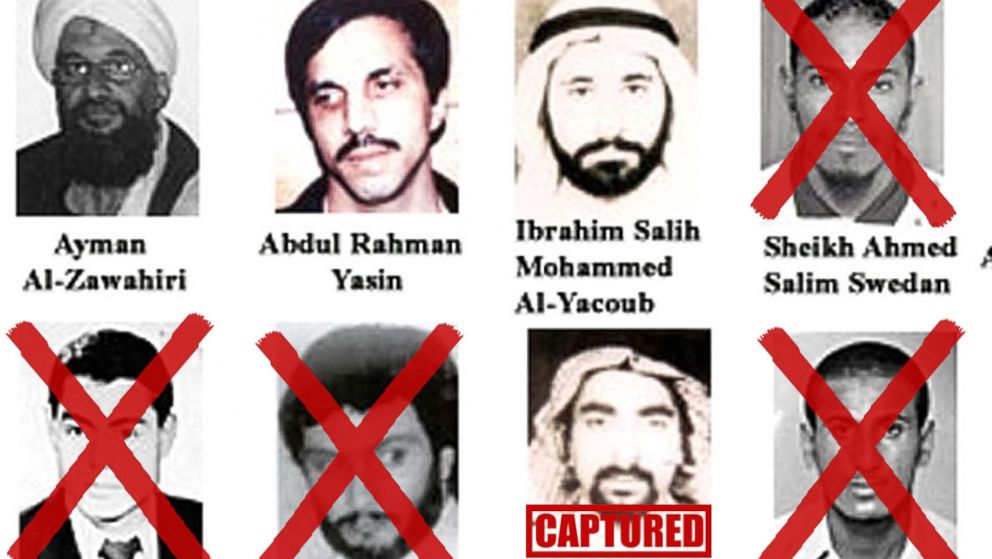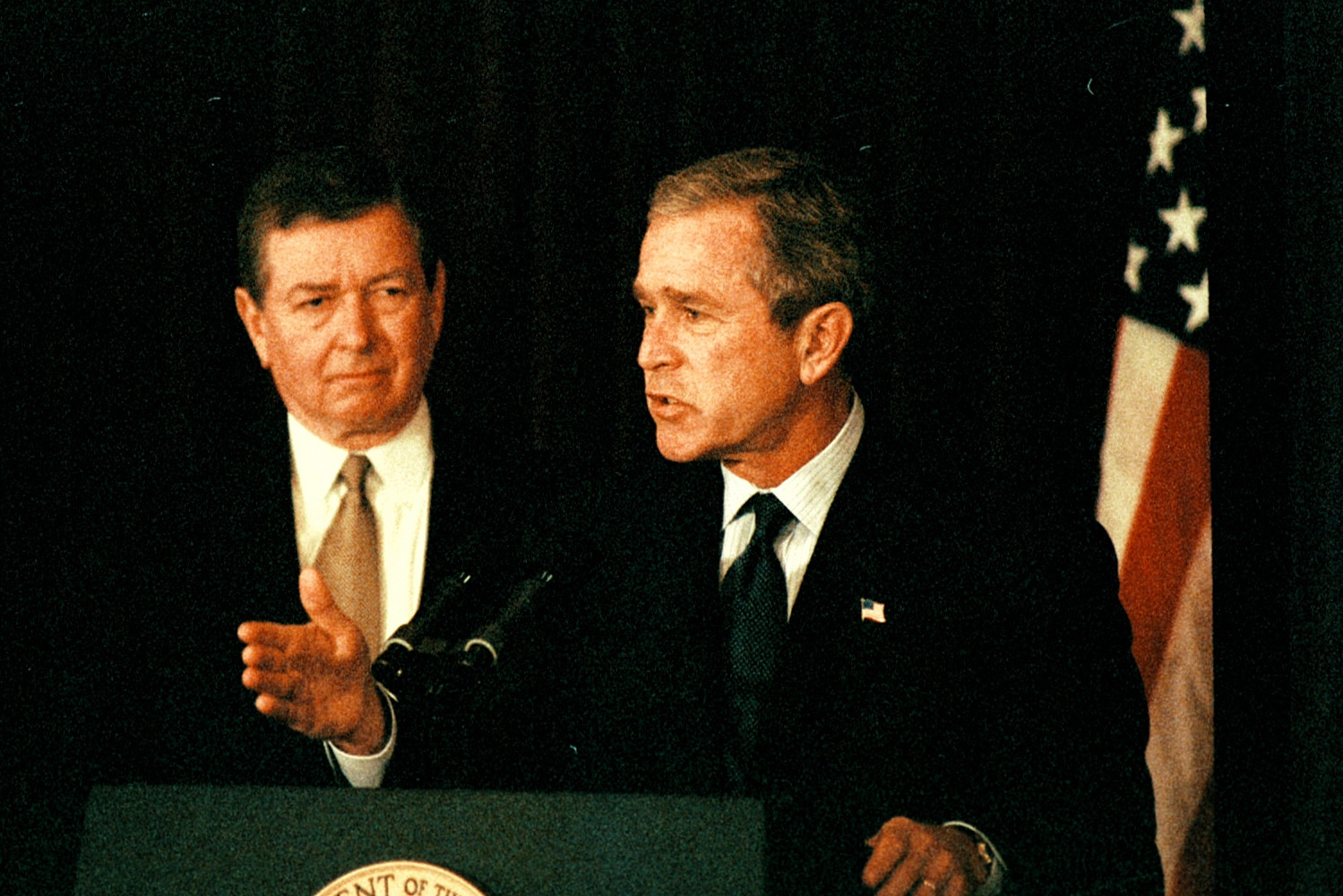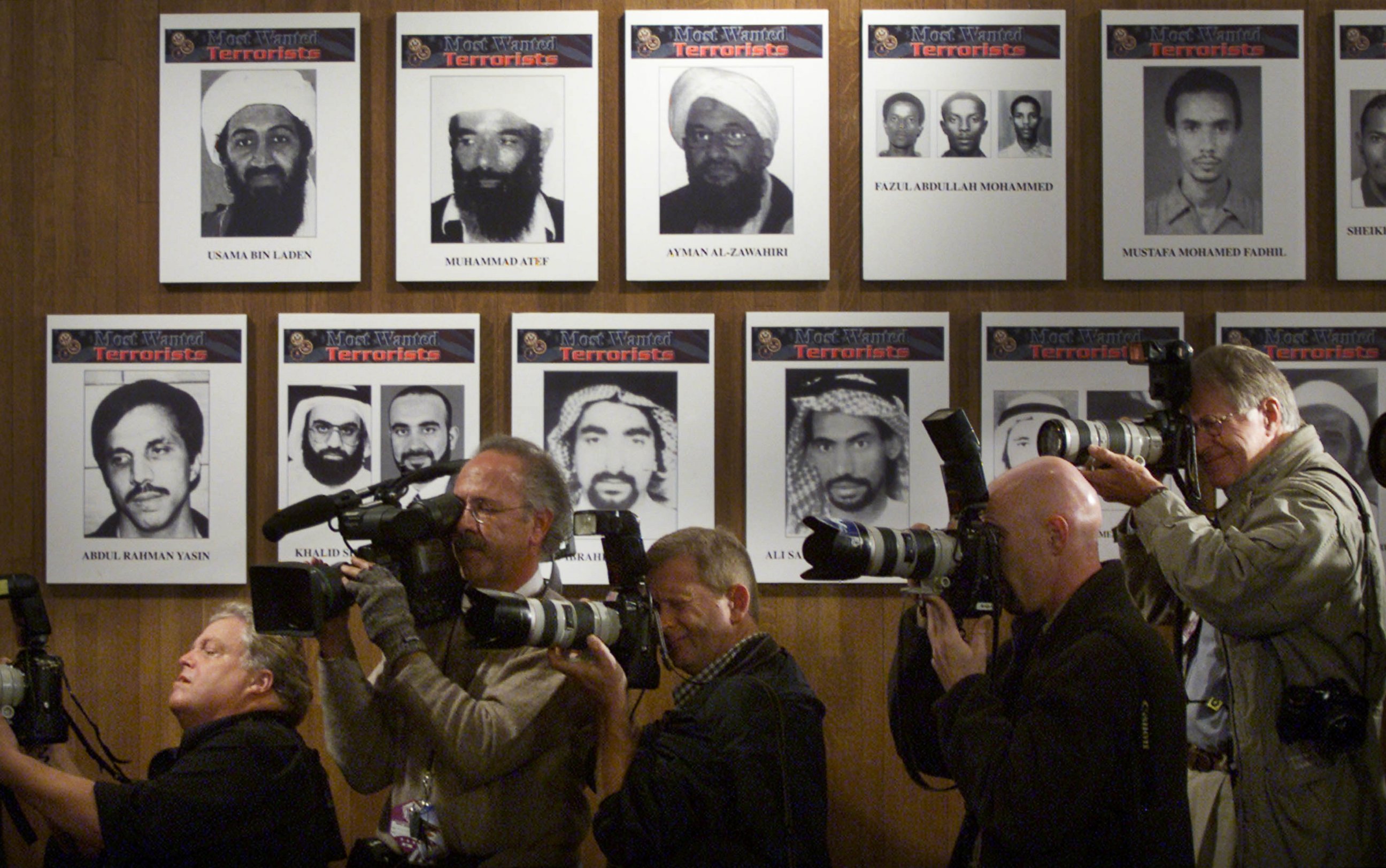FBI's Most Wanted Terrorists 15 Years Later: The Ones Who Got Away
U.S. government is 9-4-9 when it comes to the original 22 most wanted.

— -- Fifteen years ago this month, then-President George W. Bush responded to 9/11 by publicly placing 22 top terrorists on an FBI most wanted list. In the decade and half since, more of the original list of fugitives have been killed than caught, while several remain on the run — including two senior al-Qaeda figures believed to now be in Syria and the current leader of the terrorist organization.
The now well-known FBI's Most Wanted Terrorists list was created when Bush strode onto a stage at the FBI's Washington headquarters on Oct. 10, 2001, and named 22 of the "most dangerous" people in the world. Many had a $5 million reward for information leading to their capture, and right at the top of the list was Osama bin Laden, worth $25 million.
"Everybody felt like, what are we doing, and what can we show people?" Thomas Pickard, who was then the FBI deputy director and was briefly its acting director, told ABC News.
He and other former senior FBI officials told ABC News that in the weeks after 9/11, officials were racing to investigate the attacks and prevent a follow-on strike and also were eager to show the American public that they were going to hold not just al-Qaeda accountable but also anyone who orchestrated acts of terrorism against U.S. citizens.

In addition to al-Qaeda members, fugitives among what Bush called "the first 22" included members of Hezbollah groups in Lebanon and Saudi Arabia wanted for attacks that killed Americans in 1985, 1996 and in 1998.
Support for Bush was high in October 2001, and the president — only nine months on the job — paused as he took to the lectern in a theater at FBI headquarters to a sustained round of applause from government officials gathered to hear his remarks, which were televised live. At his side were Attorney General John Ashcroft, Secretary of State Colin Powell and FBI Director Robert Mueller.
"They must be found, they will be stopped, and they will be punished," Bush said of the terrorists. "Eventually, no corner of the world will be dark enough to hide in."
His statement has been as right as wrong.
Nine of the 22 whose faces appeared on flash cards given to reporters at the FBI that day have been killed in the last 15 years — at least four by American military airstrikes in Afghanistan or CIA drone strikes in Pakistan, according to the U.S. government. Five others were killed by other means, some still unknown.
Four have been captured. Two were nabbed by the CIA in Pakistan and remain in prison in Guantanamo Bay: 9/11 mastermind Khalid Shaikh Mohammed and Ahmed "Foopie" Ghailani, an al-Qaeda operative wanted for his role in the bombings of two U.S. embassy bombings in 1998 in East Africa.
A third, Abu Anas al-Liby, was caught by Delta Force in Libya in 2013 but died last year of liver disease before he could face trial in New York. The fourth, a Saudi Hezbollah operative who allegedly helped al-Qaeda bomb the Khobar Towers barracks for U.S. Air Force personnel in Saudi Arabia in 1996, was reportedly caught last year, though the FBI still lists him as a fugitive.
The others — nine alleged terrorists — remain on the loose, including three men the U.S. government would desperately like to get its hands on.
Saif al-Adel is the more prominent of the two senior al-Qaeda members now believed to be in Syria with al-Qaeda affiliate al-Nusra Front. The other is Abdullah Ahmed Abdullah. Al-Adel is a senior official on al-Qaeda's military committee who the U.S. government says was deeply involved in the devastating August 1998 twin truck bombings of the American embassies in Tanzania and Kenya, which killed hundreds of people.
Both al-Adel and Abdullah were under house arrest in Iran for more than a decade after escaping the U.S. military campaign in Afghanistan and were safe from America and its allies there. In Syria, however, they could finally face justice.
As the head of the FBI’s international terrorism operations section, Mike Rolince had a front-row seat for Bush’s 2001 announcement. While al-Qaeda leaders who relocated to Iran may have survived the 2000s, moving to Syria means they’re vulnerable to U.S. armed drones, which have been used for targeted killings of senior ISIS and al-Qaeda leaders in Syria, he said.
"If they're in Syria, that's probably a more fitting fate than a federal prison," said Rolince, who has remained active in the intelligence community since retiring from the FBI.
“Saif Adel sits above the rebranded Nusra Front in al-Qaeda's pecking order. He helps oversee al-Qaeda's global operations, mainly its role in various insurgencies, especially Syria,” said Thomas Joscelyn, an expert on the group at the Foundation for the Defense of Democracies.
Al-Adel likely travels between Syria and southern Turkey, where the U.S. intelligence community has said al-Qaeda maintains a “node” plotting attacks against the West, Joscelyn said.
The top remaining fugitive Bush named 15 years ago is Ayman al-Zawahiri, bin Laden's longtime No. 2 and the current head of al-Qaeda. The intelligence community has at times said al-Zawahiri, an Egyptian, was hiding in Afghanistan and at other times said he most likely was hiding out in a teeming Pakistani city, likely protected by current or former agents of that country’s military intelligence service.

The State Department's Rewards for Justice program, which administers cash payouts to tipsters, says the U.S. has shelled out $117 million since 2001 to 58 informants. But officials have never disclosed who received money because their personal security is guaranteed only by anonymity. None of the successful tip-driven cases it touts today by name involved al-Qaeda figures brought to justice.
Many other al-Qaeda leaders were known to the FBI in 2001 but not placed on its publicized list. Bush kept those on a sheet of paper in his Oval Office desk drawer, which he would pull out from time to time to scratch off the names of those killed in CIA drone strikes in Pakistan.
Another 22 accused terrorists have been added since the 2001 FBI list, for a total of 44 Most Wanted Terrorists publicized to date. In addition to the nine now dead from the original group, nine others placed on the list after 2001 are known to have been killed by U.S. airstrikes, such as al-Qaeda in Iraq leader Abu Musab al-Zarqawi, or even by fellow jihadis, as was the case with American al-Shabab commander Omar Hammami of Daphne, Alabama, who was killed by other al-Shabab fighters in Somalia.
None of those added over the past 15 years have been captured alive.
"I don't have a problem with that, with taking people out before they take your people out," said Rolince, who led the hunt for many years.
The current FBI list includes fugitives from the Abu Nidal organization, Palestinian Islamic Jihad, al-Qaeda, Hezbollah, Abu Sayyaf and Jemaa al-Islamiyya — but none from ISIS, such as its leader, Abu Bakr al-Baghdadi, despite the group's notoriety as the greatest terrorist threat to American interests, according to the Obama administration.
Back in 2001, senior officials viewed the creation of a most wanted list specifically for terrorists to be part of America's going to war against al-Qaeda and other terrorists and the FBI's difficult transformation from a reactive agency investigating terrorism after it occurred to its new top priority of preventing attacks.
"It meant we were now on the front lines in the war and that we had to prevent terrorist incidents before laws were necessarily broken. A real game changer," Rex Tomb, who ran the FBI's fugitive publicity unit and was one of the architects of the Most Wanted Terrorists list, told ABC News.
Launching the program while the ruins of the World Trade Center still smoldered, in that way, was as much a psychological statement to reassure a nation still rattled by the destruction in New York, Pennsylvania and in Washington as much as it was a plea for the worldwide public's assistance in finding al-Qaeda's leadership in hiding, said the retired official.
"It served to reassure the American and, indeed, the Western public that our government was doing all in its power to protect citizens from those who were committed to their destruction and the disruption of Western societies," said Tomb, who served 38 years at the bureau.
Joscelyn said the mixed results over the past 15 years are hard to assess, since most of those brought to justice were the result of worldwide intelligence operations. "I don't think it was a total waste of time, but it had only a limited impact," he said.
The Original 22: The Dead
[The information on the individuals below is based on public remarks by government officials and terrorist groups, published reports and interviews with officials involved in tracking the fugitives.]
Osama bin Laden Though bin Laden was blamed for 9/11 the day of the attacks, the FBI officially sought his indictment and pursuit in October 2001 for the bombings of two U.S. embassies in East Africa, which killed hundreds of people. U.S. Navy SEALs killed him during a 2011 raid in Pakistan.
Muhammed Atef Also wanted for the embassy attacks, al-Qaeda's military chief was killed in the U.S. onslaught in Afghanistan, in November 2001.
Fazul Abdullah Mohammed A notorious leader of al-Qaeda in East Africa, Mohammed was gunned down at a police checkpoint in Somalia by transitional government troops in what was believed to have been an confrontation set up by members of the jihadi insurgent group al-Shabab, according to a report in The CTC Sentinel, published by West Point. Mohammed was wanted for his purported link to the 1998 embassy bombings.
Mustafa Mohamed Fadhil Also wanted for the embassy attacks, Fadhil was killed in Afghanistan sometime after 9/11, which al-Qaeda confirmed years later, in 2013.
Fahid Mohammed Ally Msalam Msalam was alleged by the U.S. to have bought the vehicles packed with explosives that targeted the embassies in the 1998 bombings. In 2009 a CIA drone killed him in Pakistan's tribal areas with a fellow most-wanted fugitive, his aide Sheikh Ahmed Salim Swedan.
Sheikh Ahmed Salim Swedan Also wanted for the embassy attacks, Swedan was killed in the 2009 CIA drone strike with Msalam.
Ahmed Mohammed Hamed Ali Ali was reported killed in 2011 by a CIA drone strike in Pakistan's tribal areas, and his most-wanted poster was removed from the Rewards for Justice website. He too was wanted in connection to the embassy bombings.
Mushin Musa Matwalli Atwab Atwab was killed in 2006 during military operations by Pakistani forces along the border with Afghanistan. Atwab was believed to be an al-Qaeda operative linked to the embassy bombings.
Imad Mugniyah Mugniyah was wanted for the 1985 hijacking of TWA Flight 847, in which U.S. sailor Robert Stethem was tortured and murdered. Mugniyah, said to be a founder of Lebanese Hezbollah and in the top tier of the group's leadership, was killed by a car bomb in Damascus, Syria, in 2008.
The Captured
Khalid Shaikh Mohammed Mohammed, known as KSM, was the admitted mastermind of the 9/11 attacks. He was officially wanted for an airline bomb plot in the Philippines in 1995.
Ahmed Ibrahim al-Mughassil Wanted for the 1996 Khobar Towers bombing in Saudi Arabia, which left 19 American airmen dead. It was al-Qaeda's last collaboration with Saudi Hezbollah, in which al-Mughassil served as military commander. He was reported captured in 2015, but the FBI still lists him as a fugitive.
Ahmed Khlfan Ghailani The diminutive Qaeda operative known as Foopie was nabbed in Pakistan in 2004 and tried in New York in 2011 for his connection to the 1998 embassy bombings. He is serving a life sentence at the Supermax federal prison in Florence, Colorado.
Anas al-Liby Al-Liby evaded justice for 15 years after the embassy bombings in 1998, but eventually U.S. special forces caught up to him in the streets of Tripoli, Libya, in 2013. He was sent to the U.S. to stand trial but died in New York, reportedly of liver cancer, just days before the trial was scheduled to begin.
The Ones Who Got Away, So Far
Ayman al-Zawahiri After bin Laden's 2011 death, al-Zawahiri, an Egyptian doctor once implicated in the conspiracy to assassinate Egyptian President Anwar Sadat, rose to become al-Qaeda's top leader, where he has spoken out against ISIS while renewing the group's threats to America. He is technically wanted for his role in the 1998 embassy bombings, for which he was indicted in the U.S.
Abdullah Ahmed Abdullah Also wanted for the embassy attacks, al-Zawahiri's fellow Egyptian is said to be in the senior leadership of al-Qaeda. He was under house arrest in Iran for more than a decade until his release last year. He is suspected to be in Syria with al-Qaeda fighters there.
Saif al-Adel A former colonel in the Egyptian military, al-Adel is believed also to have been under house arrest in Iran, until 2010 or 2013. This year he was reported to have been sent to Syria in his role as a senior member of al-Qaeda's military committee. He is wanted for his purported role in the 1998 embassy bombings.
Hassan Izz al-Din Al-Din, a purported Hezbollah member, is wanted for his alleged role in the hijacking of TWA 847. He remains sought by the FBI and is thought to reside in Lebanon, the bureau says.
Ali Atwa Also wanted for TWA 847, this Hezbollah member also is thought to be in Lebanon.
Abdul Rahman Yasin Yasin is wanted for his role in the first World Trade Center attack in 1993. The Indiana-born bombmaker was interviewed by the FBI and then returned to Iraq, where he had lived and studied. After a 2002 media interview, he vanished and was never located by the U.S. after the 2003 invasion of Iraq.
Ali Saed bin Ali al-Hoorie Al-Hoorie is believed to be a veteran of an unprecedented collaboration between Sunni al-Qaeda and Shiite Saudi Hezbollah. He's on the run, indicted in Virginia for his alleged role in the Khobar Towers attack.
Ibrahim Salih Mohammed al-Yacoub Also wanted for the Khobar Towers attack, al-Yacoub is considered a member of the outlaw pro-Iranian group Saudi Hezbollah.
Abdelkarim Hussein Mohamed al-Nasser Al-Nasser was also indicted for his alleged role in the Khobar Towers attack. He remains a fugitive, with past reports suggesting his presence in Iran.




